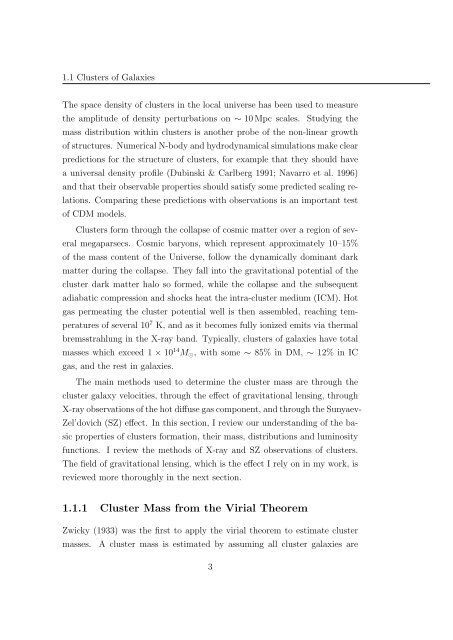Mass and Light distributions in Clusters of Galaxies - Henry A ...
Mass and Light distributions in Clusters of Galaxies - Henry A ...
Mass and Light distributions in Clusters of Galaxies - Henry A ...
Create successful ePaper yourself
Turn your PDF publications into a flip-book with our unique Google optimized e-Paper software.
1.1 <strong>Clusters</strong> <strong>of</strong> <strong>Galaxies</strong><br />
The space density <strong>of</strong> clusters <strong>in</strong> the local universe has been used to measure<br />
the amplitude <strong>of</strong> density perturbations on ∼ 10 Mpc scales. Study<strong>in</strong>g the<br />
mass distribution with<strong>in</strong> clusters is another probe <strong>of</strong> the non-l<strong>in</strong>ear growth<br />
<strong>of</strong> structures. Numerical N-body <strong>and</strong> hydrodynamical simulations make clear<br />
predictions for the structure <strong>of</strong> clusters, for example that they should have<br />
a universal density pr<strong>of</strong>ile (Dub<strong>in</strong>ski & Carlberg 1991; Navarro et al. 1996)<br />
<strong>and</strong> that their observable properties should satisfy some predicted scal<strong>in</strong>g relations.<br />
Compar<strong>in</strong>g these predictions with observations is an important test<br />
<strong>of</strong> CDM models.<br />
<strong>Clusters</strong> form through the collapse <strong>of</strong> cosmic matter over a region <strong>of</strong> several<br />
megaparsecs. Cosmic baryons, which represent approximately 10–15%<br />
<strong>of</strong> the mass content <strong>of</strong> the Universe, follow the dynamically dom<strong>in</strong>ant dark<br />
matter dur<strong>in</strong>g the collapse. They fall <strong>in</strong>to the gravitational potential <strong>of</strong> the<br />
cluster dark matter halo so formed, while the collapse <strong>and</strong> the subsequent<br />
adiabatic compression <strong>and</strong> shocks heat the <strong>in</strong>tra-cluster medium (ICM). Hot<br />
gas permeat<strong>in</strong>g the cluster potential well is then assembled, reach<strong>in</strong>g temperatures<br />
<strong>of</strong> several 10 7 K, <strong>and</strong> as it becomes fully ionized emits via thermal<br />
bremsstrahlung <strong>in</strong> the X-ray b<strong>and</strong>. Typically, clusters <strong>of</strong> galaxies have total<br />
masses which exceed 1 × 10 14 M ⊙ , with some ∼ 85% <strong>in</strong> DM, ∼ 12% <strong>in</strong> IC<br />
gas, <strong>and</strong> the rest <strong>in</strong> galaxies.<br />
The ma<strong>in</strong> methods used to determ<strong>in</strong>e the cluster mass are through the<br />
cluster galaxy velocities, through the effect <strong>of</strong> gravitational lens<strong>in</strong>g, through<br />
X-ray observations <strong>of</strong> the hot diffuse gas component, <strong>and</strong> through the Sunyaev-<br />
Zel’dovich (SZ) effect. In this section, I review our underst<strong>and</strong><strong>in</strong>g <strong>of</strong> the basic<br />
properties <strong>of</strong> clusters formation, their mass, <strong>distributions</strong> <strong>and</strong> lum<strong>in</strong>osity<br />
functions. I review the methods <strong>of</strong> X-ray <strong>and</strong> SZ observations <strong>of</strong> clusters.<br />
The field <strong>of</strong> gravitational lens<strong>in</strong>g, which is the effect I rely on <strong>in</strong> my work, is<br />
reviewed more thoroughly <strong>in</strong> the next section.<br />
1.1.1 Cluster <strong>Mass</strong> from the Virial Theorem<br />
Zwicky (1933) was the first to apply the virial theorem to estimate cluster<br />
masses. A cluster mass is estimated by assum<strong>in</strong>g all cluster galaxies are<br />
3
















